Texas embraces adventurous extroversion. The phrase, “Everything is bigger in Texas,” isn’t just for show – indeed, the state has bigger everything.
Physically, there are bigger buildings, wide-open spaces, plentiful food, and larger-than-average hats and boots. In terms of area and population, Texas is the second-largest state in the United States, right after Alaska.
It doesn’t skimp on natural resources and wildlife, either. From glamorous, aerobatic hummingbirds to fierce falcons patrolling fields and forests, Texas is among the most bird-diverse states in the nation with 660 species.
Here are 25 of the best native birds to see on your next bird-watching trip!
Red Birds in Texas
Northern Cardinal

- Scientific Name: Cardinalis cardinalis
- Length: 8.3 to 9.1 in.
- Weight: 1.5 to 1.7 oz.
- Wingspan: 8.9 to 12.2 in.
Northern cardinals, with their bright red bodies and cone-shaped reddish bills, are year-round residents across the eastern two-thirds of Texas. They’re fairly large and long-tailed, often sitting on high trees with hunched-over postures.
Male cardinals are among the most aggressive cardinals in the state, known to vigorously defend their territories from other wild birds. They’re so aggressive that they’d even attack their own reflections and small red objects they mistake for other males.
These fully red birds are widespread and abundant, often seen in shrubby forest edges, parks, woodlots, and backyards.
Common Redpoll
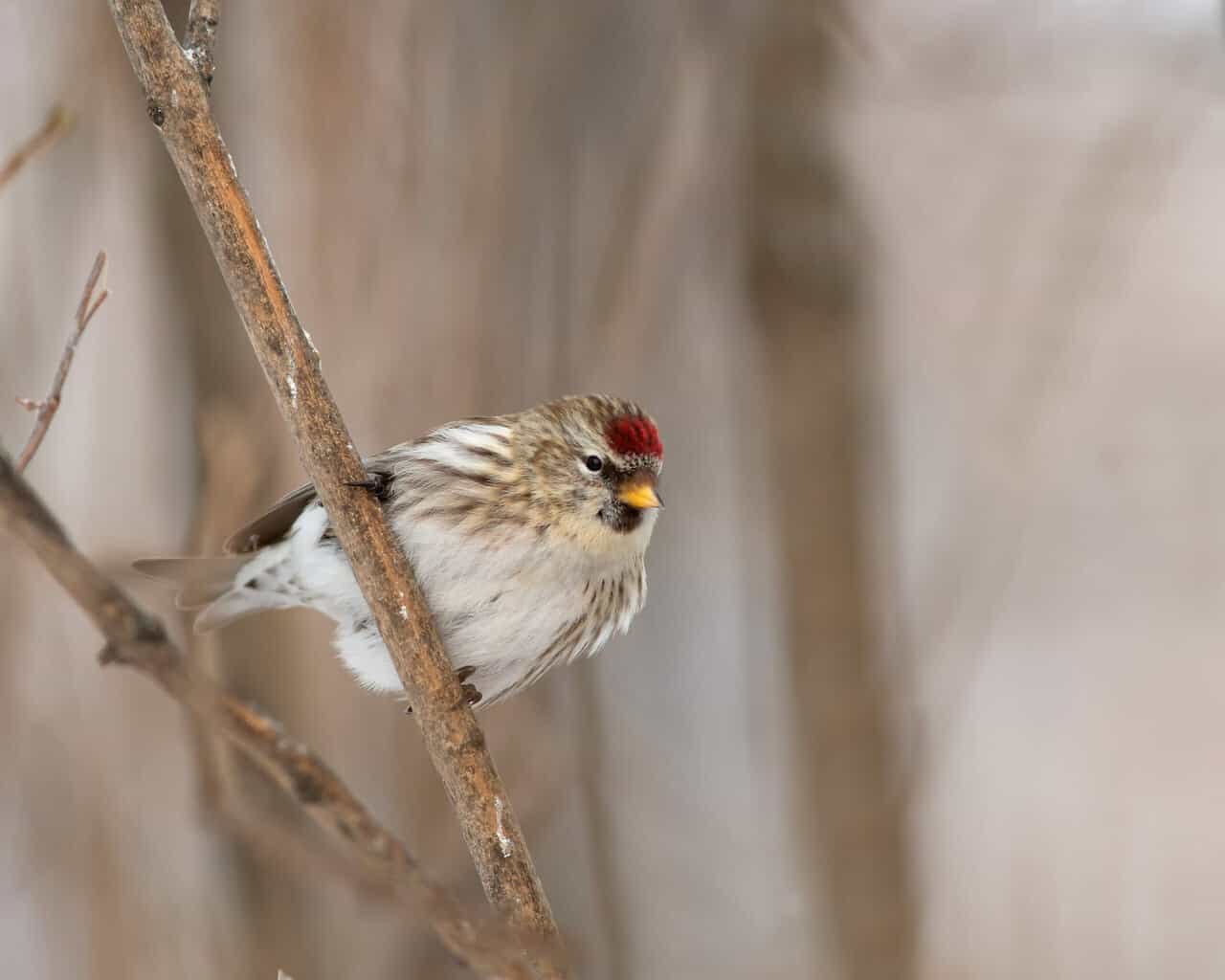
- Scientific Name: Acanthis flammea
- Length: 4.5 to 5.5 in.
- Weight: 0.42 to 0.56 oz.
- Wingspan: 7.5 to 8.7 in.
Plump and petite but spectacular and fierce, Common redpolls are active foragers that often travel in big flocks. They’re rare winter visitors of Texas, which makes them a sight to see when randomly spotted in open conifer forests and weedy fields.
Common redpolls are characterized by their streaked red above and pinking red below. Their tails are short with singular notches at the tip.
Along with vegetables, these tiny songbirds actively feed on seeds found in trees and weeds. In summer, they occasionally eat insects.
White-Winged Crossbill

- Scientific Name: Loxia leucoptera
- Length: 5.9 to 6.7 in.
- Weight: 0.8 to 0.9 oz.
- Wingspan: 10.2 to 11.0 in.
White-winged crossbills are small passerine birds with pinkish-red bodies, black wings, and heavily crossed beaks. They remain in flocks year-round in Texas, even during nesting season.
These active and popular birds are rarely found away from conifer forests, preferring boreal forests like tamarack, hemlock, and spruce.
White-winged crossbills mainly feed on spruce seeds, prying open spruce cones with their peculiar crossed bills. They also favor weed seeds, berries, buds, and the occasional insect.
Young mostly feed on regurgitated seeds and salt.
Pine Grosbeak
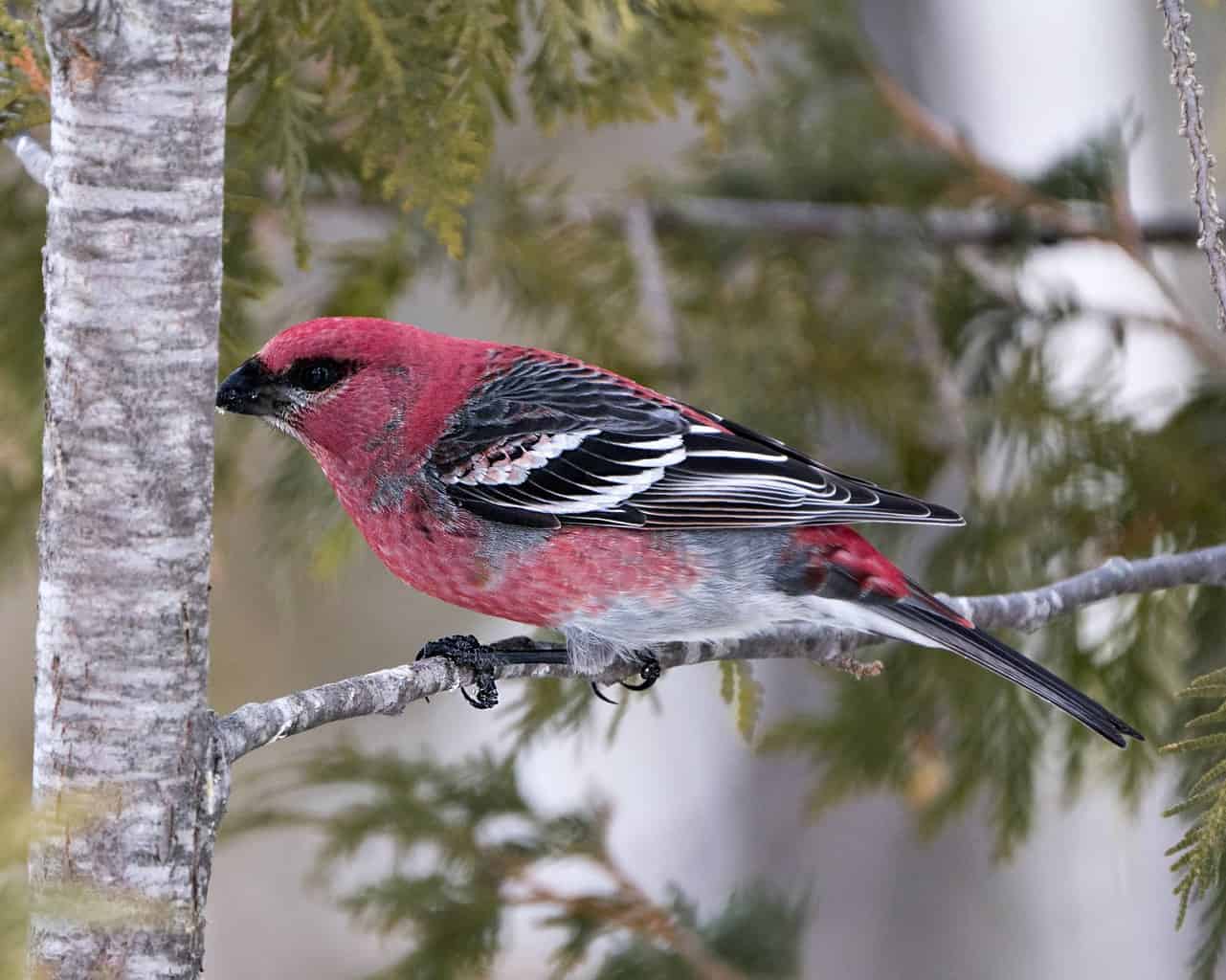
- Scientific Name: Pinicola enucleator
- Length: 9 to 10 in.
- Weight: 1.8 to 2.8 oz.
- Wingspan: 12 to 13 in.
Pine grosbeaks are among the largest finches found in Texas. Although widespread, they’re often easy to overlook, primarily because they tend to sit motionless when birdwatchers walk by.
Male Pine grosbeaks have red-washed black backs, pink-red rumps, and grayish-red underparts. Females and juveniles are mostly gray with reddish-orange heads and rumps.
Like most finches, Pine grosbeaks inhabit subalpine and open forests of pine, fir, and spruce. In winter, they’re mostly found in areas with plenty of maple and ash.
Although absurdly tame, Pine grosbeaks easily nip off tree buds and crush seeds with their stubby, thick bills.
Summer Tanager
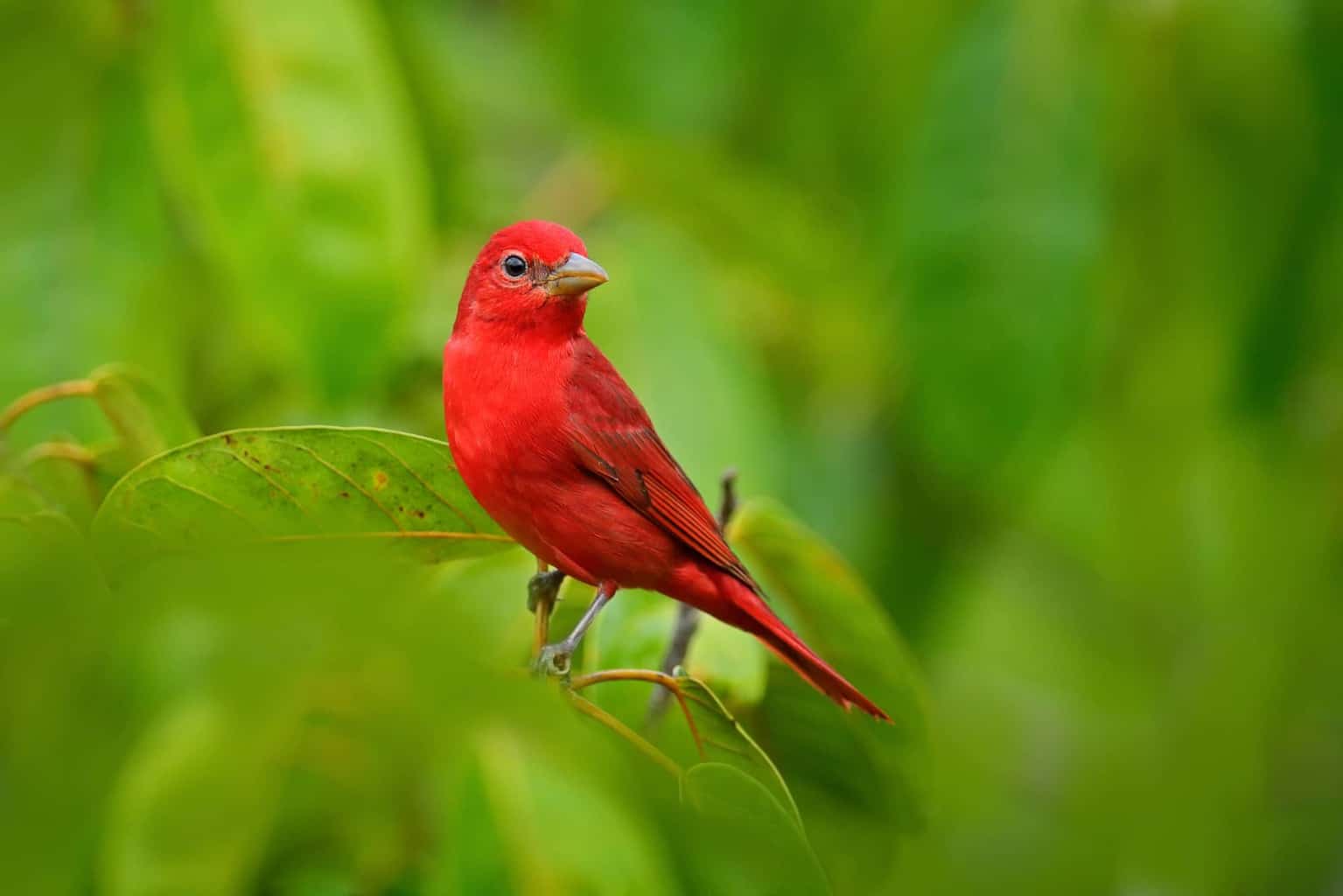
- Scientific Name: Piranga rubra
- Length: 6.1 to 6.9 in.
- Weight: 0.8 to 1.1 oz.
- Wingspan: 11.1 to 11.9 in.
Trim and elegant, Summer tanagers, also called Summer redbirds, are neotropical migrants that arrive in Texas from late March to mid-May.
In terms of color pattern, male Summer tanagers and female Summer tanagers are complete opposites. Males are entirely bright red, while females are entirely bright yellow.
Summer tanagers breed near edges and gaps of open forests, particularly in mixed pine-oak woodlands and deciduous trees.
Although they mostly eat insects like wasps and bees, these medium-sized American songbirds tend to forage in backyard fruit trees and berry bushes near their habitats.
Red-Headed Woodpecker
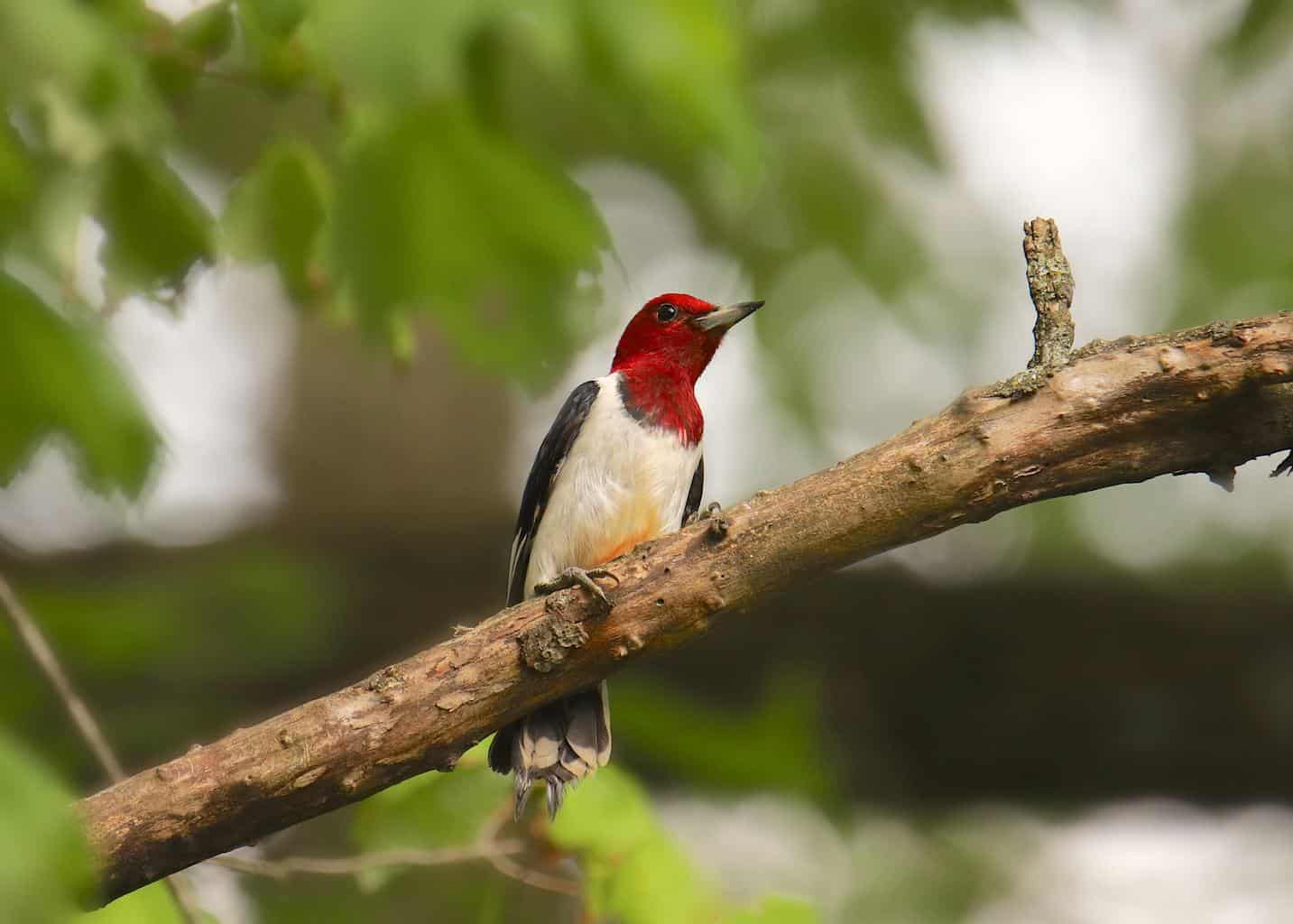
- Scientific Name: Melanerpes erythrocephalus
- Length: 7.5 to 9.1 in.
- Weight: 2.0 to 3.2 oz.
- Wingspan: 16.5 in.
With brilliant crimson heads, snow-white bodies, and black backs, Red-headed woodpeckers are among the most stunning woodpeckers in Texas. As they can be seen miles away, they earned the title “flying checkerboards.”
Red-headed woodpeckers are unique in both color pattern and personality. Unlike most woodpeckers, Red-headed woodpeckers have an extremely vast diet, often consisting of nuts, insects, small rodents, and even other birds’ eggs and nestlings.
For this reason, Red-headed woodpeckers are arguably the most omnivorous of woodpeckers.
Vermilion Flycatcher
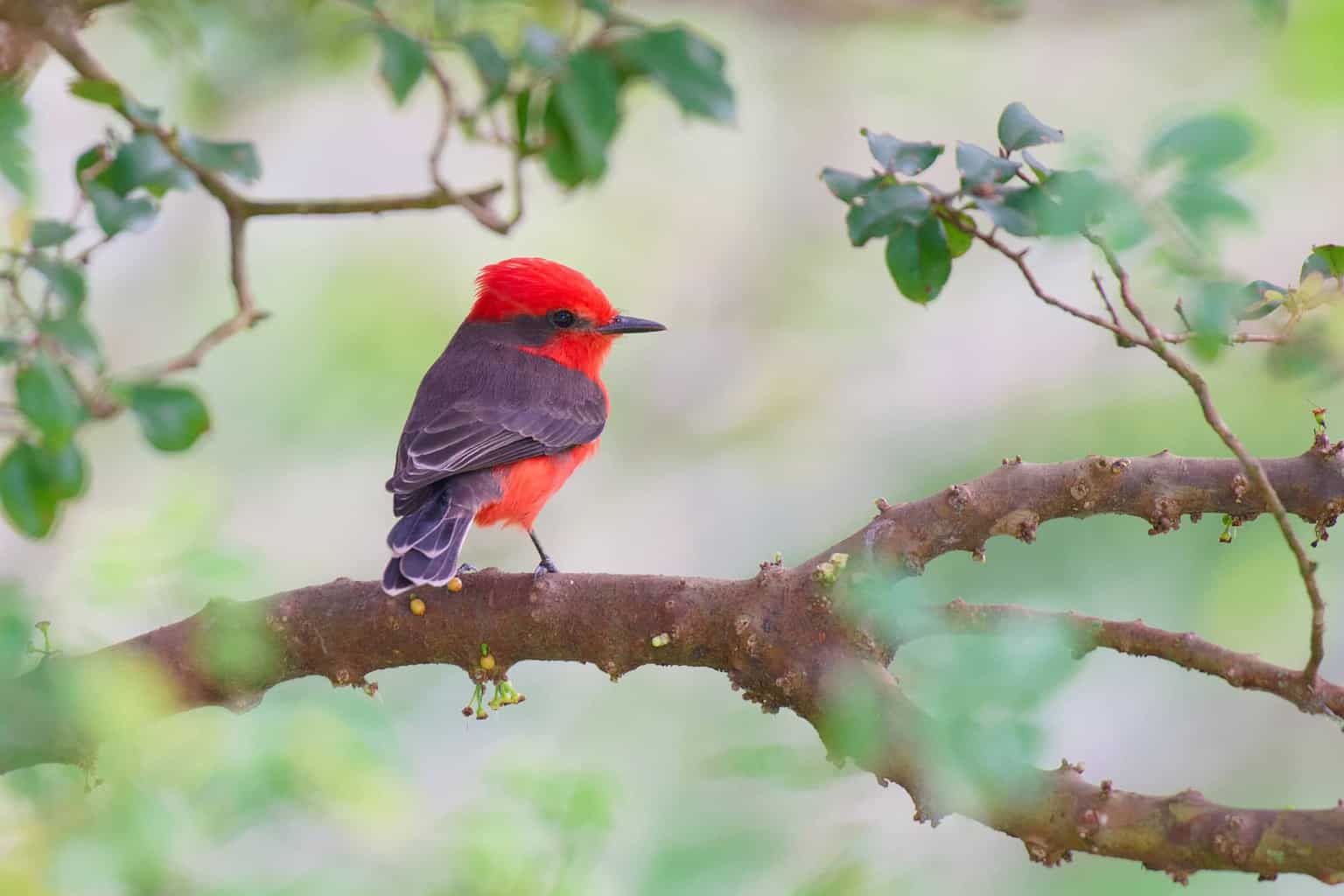
- Scientific Name: Pyrocephalus rubinus
- Length: 4.8 to 5.4 in.
- Weight: 0.4 to 0.5 oz.
- Wingspan: 9.4 to 9.8 in.
Vermilion flycatchers, as the name suggests, are vibrant red birds that expertly capture flying insects from their wings. They’re usually seen perched in low, open areas near the water with their tails dipped in—like phoebes—alongside fence posts along roadsides and woodlands.
In Texas, Vermilion flycatchers are among the most conspicuous birds. Their brilliant orange-red bodies can be seen fluttering high in the air from miles away as they repeatedly sing the song of their people.
Vermilion flycatchers primarily feed on insects. Although their diets aren’t extensively documented, they’re believed to entirely feed on beetles, wasps, grasshoppers, and flies.
Blue Birds in Texas
Blue Jay

- Scientific Name: Cyanocitta cristata
- Length: 8.6 to 11.8 in.
- Weight: 2.5 to 3.5 oz.
- Wingspan: 13.3 to 16.9 in.
Found all throughout the eastern half of Texas, Blue jays are identified through their jeering “jay! jay!” calls in late summer and fall. They’re large and aggressive, usually spotted on forest edges and near oaks in woodlots, parks, towns, and cities.
Boldly colored in blue, black, and white, Blue jays are known for their tight family bonds, complex social systems, and their fondness for acorns. In fact, they’re largely believed to have helped spread oak trees during and after the last glacial period.
Although they’re fairly common in Texas and travel in large groups, they’re not always conspicuous, furtively slipping through trees and shrubs in search of food.
Blue jays have a diet that mostly consists of 75% vegetable matter. During summer, they won’t say no to juicy caterpillars, small rodents, and carrion.
Blue Mockingbird
- Scientific Name: Melanotis caerulescens
- Length: 9.5 to 10.5 in.
- Weight: 1.77 to 2.11 oz.
- Wingspan: 13 to 14 in.
Blue mockingbirds are heard far more often than seen. They’re quite secretive, often found skulking about in dense underbrush in search of fallen fruit and insects.
Although widespread in South and Central America, Blue mockingbirds are regular residents of California and southern Texas, mainly on the Rio Grande.
Covered in slaty-blue plumage, these bright-eyed vagrants inhabit humid forests, riparian thickets, and dense scrubby woodlands, with elevations ranging from lowlands to 10,000 feet.
Like most mockingbirds, Blue mockingbirds primarily feed on insects, fruits, and berries. During winter, they visit feeders for fruits.
Lazuli Bunting
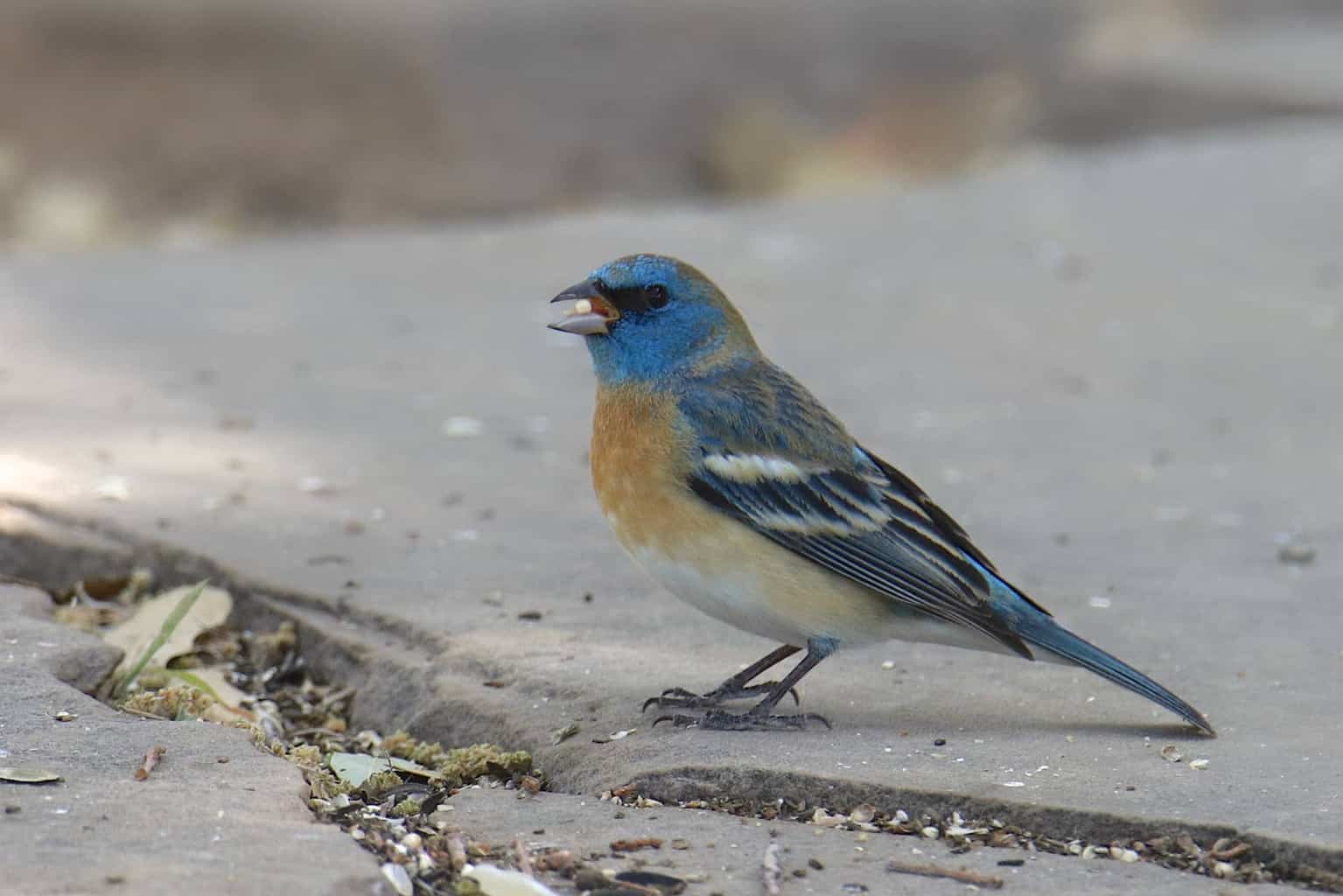
- Scientific Name: Passerina amoena
- Length: 5.1 to 5.9 in.
- Weight: 0.5 to 0.6 oz.
- Wingspan: 8.7 in.
Named after the gemstone lapis lazuli, Lazuli buntings are year-round residents of much of western, northern, and central Texas. They’re small, stocky, and finch-like in appearance with their cone-shaped bills, sloping foreheads, and forked tails.
Male Lazuli buntings are brilliant blue with white bellies and pumpkin-colored breasts. Females, while not as brightly colored, are just as stunning: grayish-brown above, blue-tinged wings, and cinnamon-brown breasts.
Like most buntings, Lazuli buntings are fairly secretive. They spend most of their time on the ground and hopping between low branches in search of insects and seeds.
Lazuli buntings are often mistaken for Indigo buntings, especially for females. Their “see-see-sweet” calls are near-identical to Indigo buntings.
Black-Throated Blue Warbler
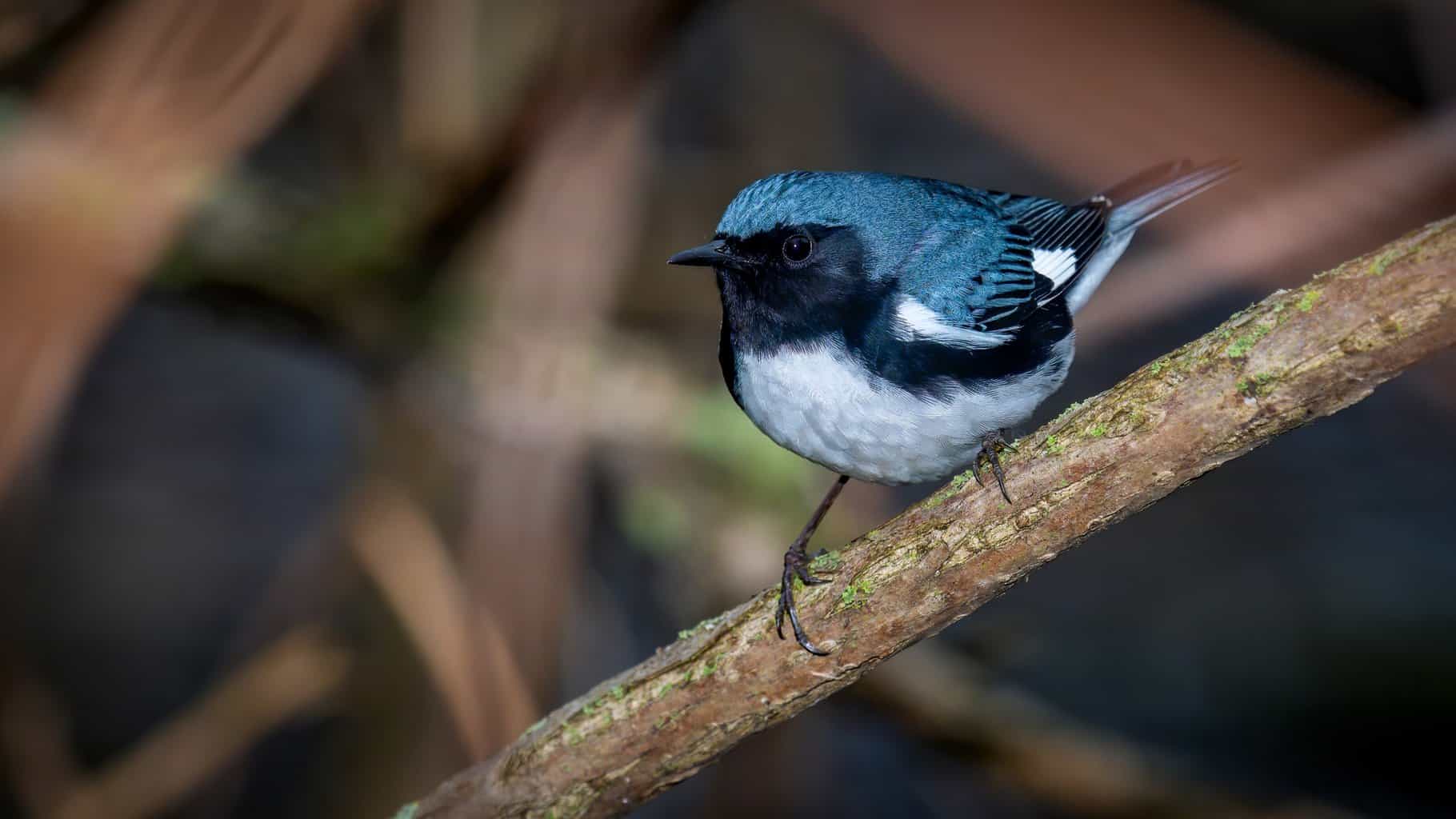
- Scientific Name: Setophaga caerulescens
- Length: 4.3 to 5.1 in.
- Weight: 0.3 to 0.4 oz.
- Wingspan: 7.5 to 7.9 in.
Aptly named for their black throats and midnight-blue backs, Black-throated blue warblers are fine-looking passerine birds with rather active personalities. They’re often spotted in Texas’s leafy eastern woods, foraging beneath shady understories and trails.
Compared to most warblers, Black-throated blue warblers are large, plump, and well-proportioned. They can be seen in mixed hardwood-evergreen forests and tracts of large. hardwood.
Green Birds in Texas
Green Jay
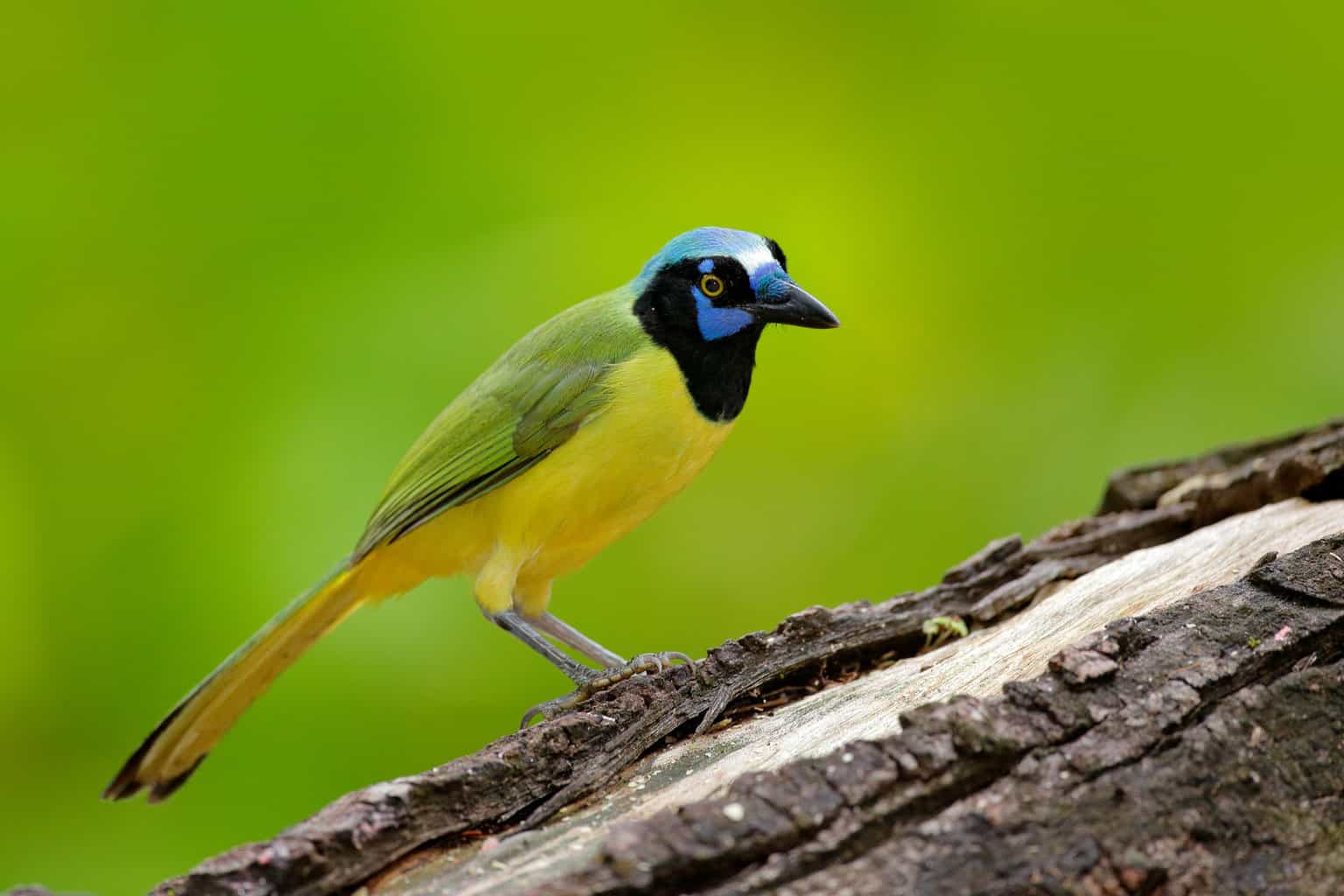
- Scientific Name: Cyanocorax luxuosus
- Length: 9.8 to 11.4 in.
- Weight: 2.3 to 3.9 oz.
- Wingspan: 13.5 in.
Green jays, once spotted, are unmistakable; with their green-and-yellow plumage and black-and-blue head pattern, they’re certainly among the most colorful birds in the Lone Star State.
These gorgeous birds mostly reside in South Texas, particularly in great parks and refuges like the Santa Ana National Wildlife Refuge. Out in the open, they’re especially hard to miss.
Green jays forage in large family flocks in search of insects, fruit, and small vertebrates. Their hunting methods consist of gleaning, pouncing, flycatching, and even picking and prying up loose bark to expose insect prey.
Buff-Bellied Hummingbird

- Scientific Name: Amazilia yucatanensis
- Length: 3.9 to 4.3 in.
- Weight: 0.14 to 0.18 oz.
- Wingspan: 5.75 in.
Buff-bellied hummingbirds are medium-sized hummingbirds with green upperparts, cinnamon-buff bellies, and red, dark-tipped bills. Males, in particular, have iridescent green throats that often appear dark at certain angles.
Arguably the least-studied hummingbirds in the US, Buff-bellied hummingbirds are the only species of their kind that regularly nest in southernmost Texas. They’re mostly found in semi-open habitats, in areas with scattered trees, woodland edges, and clearings.
Although their breeding behavior isn’t well-known, experts believe that their nesting season extends from April to August at least.
Rivoli’s Hummingbird

- Scientific Name: Eugenes fulgens
- Length: 4.3 to 5.5 in.
- Weight: 0.2 to 0.3 oz.
- Wingspan: 7.1 in.
Rivoli’s hummingbirds, formerly known as Magnificent hummingbirds, are among the biggest hummingbird species in Texas—second only to the Blue-throated mountain-gem. They mostly inhabit Texas’s pine-oak forests and shady canyons, where flowers are plentiful.
Despite their large size, Rivoli’s hummingbirds are fairly docile. Instead of pushing around other hummingbirds at flowers and birdfeeders, they use their longer-than-average bills to sip nectar by “trap lining” along widely spaced patches of flowers.
Male Rivoli’s hummingbirds are green overall with almost-black bellies and chests. Females appear duller with mottled greenish sides, grayish bellies, and speckled gray throats.
Red-Lored Parrot

- Scientific Name: Amazona autumnalis
- Length: 12 – 13.6 in.
- Weight: 10.9 to 16.9 oz.
- Wingspan: 15 to 17 in.
Prized for their stunning beauty, startling intelligence, and comical personalities, Red-lored parrots are among the most popular pet parrots across all of Texas.
Those who have escaped from captivity are often seen flying around in flocks of other feral parrots, particularly Yellow-headed and Red-crowned parrots.
Red-lored parrots flaunt vivid green feathers when flying overhead early and late in the day. They got their names from the bright red note standing brightly on their foreheads.
Like most parrots, Red-lored parrots are a monomorphic species. This means that both males and females look exactly alike, except for the almost unnoticeable color difference in their irises: golden for males, and brown for females.
Monk Parakeets
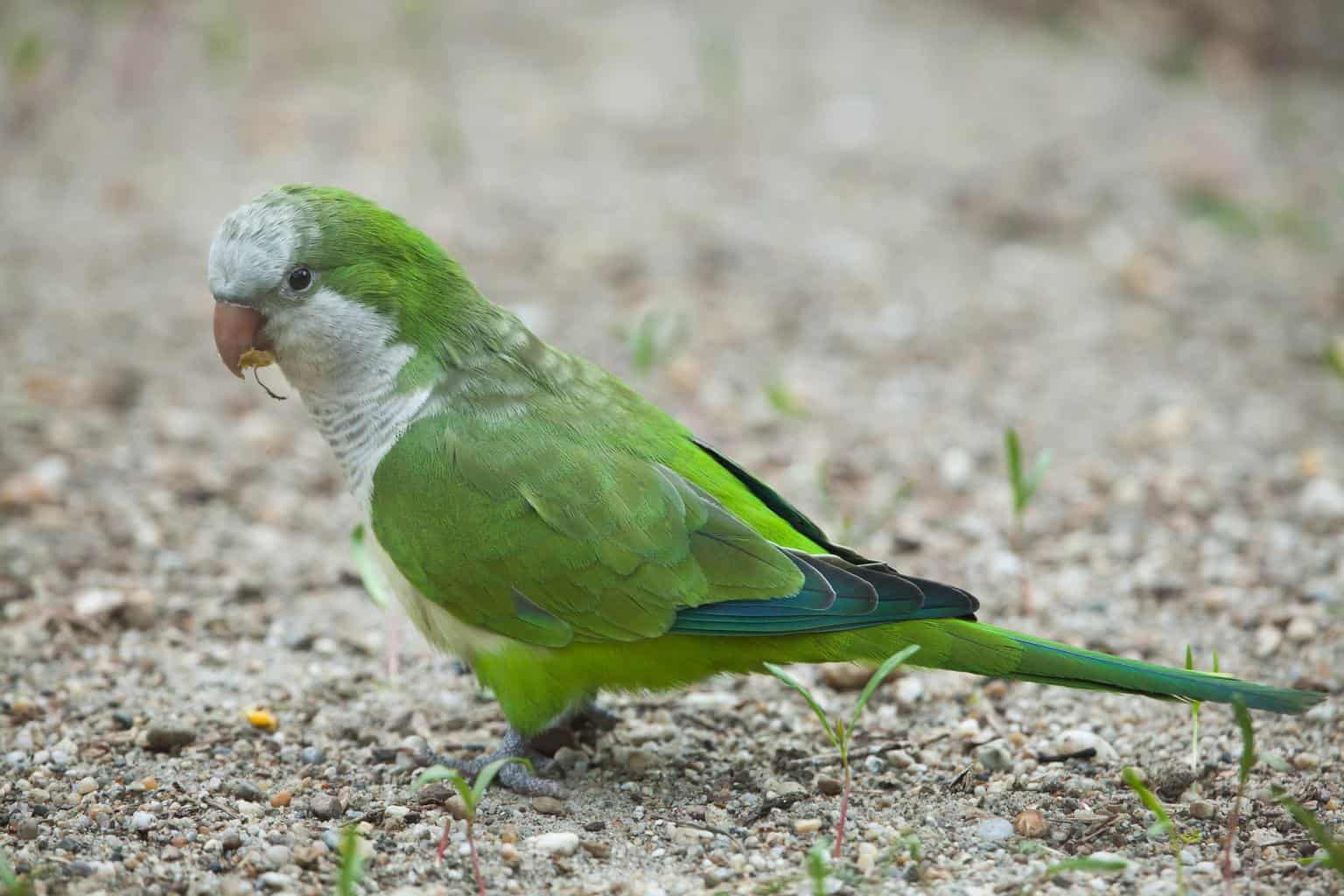
- Scientific Name: Myiopsitta monachus
- Length: 11 to 12 in.
- Weight: 3.2 to 4.2 oz.
- Wingspan: 19 in.
Monk parakeets, otherwise known as Quaker parrots or simply Green parrots, are introduced exotic birds in Texas. While they aren’t as widespread as most other parrots in the state, they’re locally common in several of Texas’s metropolitan areas.
Identified through their bright green bodies, orange bills, and blue tail feathers, Monk parakeets are the only member of the parrot family that nest colonially.
Monk parakeets mostly feed on seeds, fruits, nuts, and greens. They usually live in dry, open habitats, as well as urban and suburban settings, in multifamily groups year-round
Orange Birds in Texas
Flame-Colored Tanager

- Scientific Name: Piranga bidentata
- Length: 7.1 to 7.5 in.
- Weight: 1.2 oz.
- Wingspan: 12 in.
Flame-colored tanagers, formerly known as Stripe-backed tanagers, are rare vagrants with but a handful of sightings along the Mexican border of Texas. They’re often spotted alongside Western tanagers.
Male Flame-colored tanagers are predominantly flame-orange while females are predominantly yellowish-orange. Both sexes have bold white wing bars, as well as white tertial and tail spots.
These birds forage by deliberately moving through the foliage to capture unsuspecting insects. On occasion, they’d fly out to catch insects in mid-air.
Although their diets consist of 80% insects, they won’t say no to the occasional seed or berry.
Streak-Backed Oriole
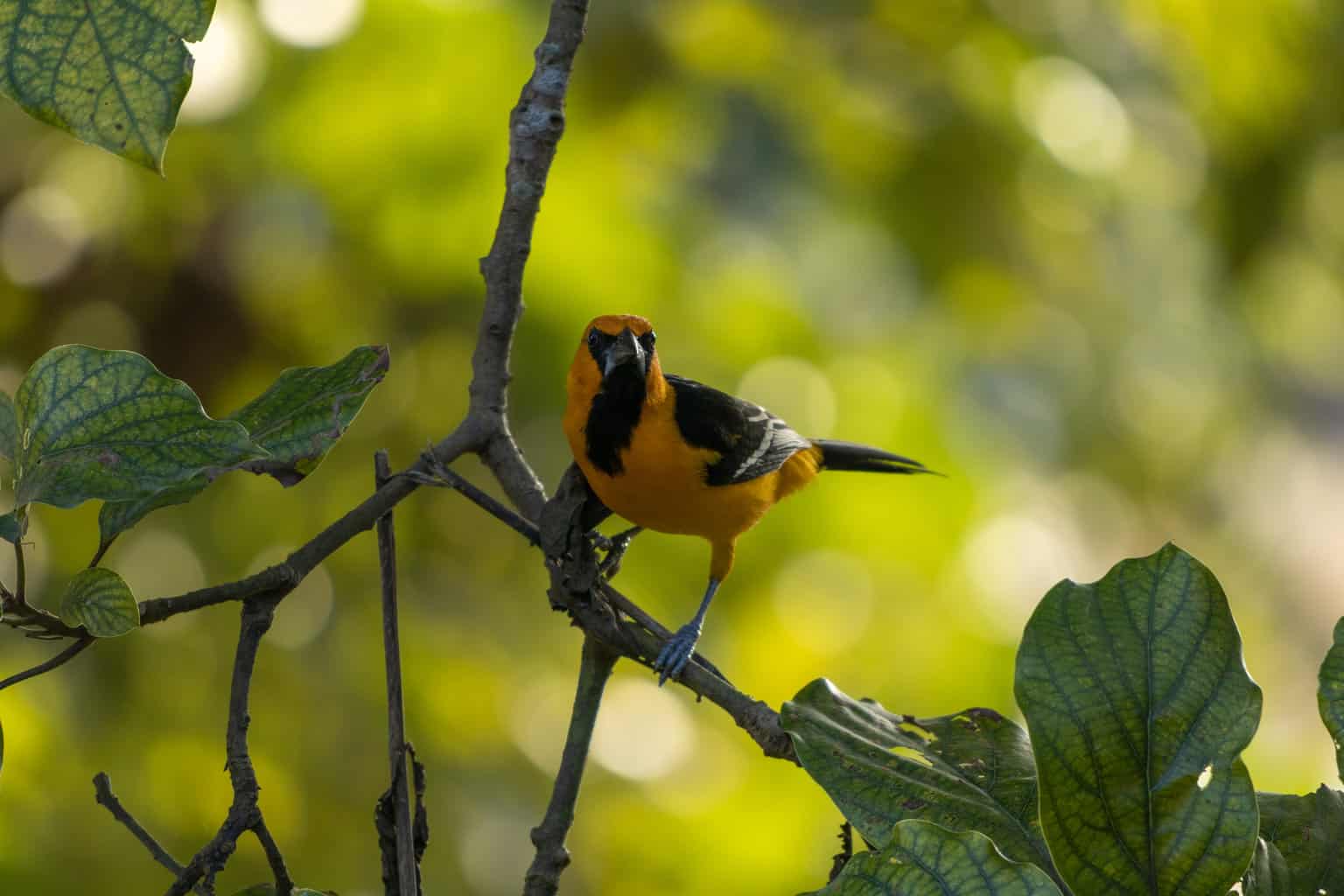
- Scientific Name: Icterus pustulatus
- Length: 7.87 in.
- Weight: 2.47 – 3 oz.
- Wingspan: 3.54 – 4.65 in.
Streak-backed orioles are quite rare in Texas and across the majority of the southwestern United States. They’re typically found in woodland edges, plantations, and semi-open areas with countless scattered trees and hedges.
Streak-backed orioles are often mistaken for Hooded orioles because they have similar color patterns: brightly orange bodies with streaked black backs and wings.
However, Streak-backed orioles are slightly larger and bulkier than their close cousins, with straighter bills and more extensive white-wing edgings.
Although considered socially monogamous, where both parents care for the young, extra-pair copulations are certainly not unheard of.
They heavily feed on insects and spiders, but will also eat seeds, nectar, fruits, and berries on occasion.
Olive Warbler

- Scientific Name: Peucedramus taeniatus
- Length:5.1 to 5.5 in.
- Weight: 0.34 to 0.42 oz.
- Wingspan: 9.1 to 9.3 in.
In Texas, there are only six recorded sightings of Olive warblers, making them among the rarest accidental species in the state. In all six instances, they were spotted in Texas’s mountainous coniferous forests.
Male Olive warblers have orange heads, grayish bodies, black “ear” patches, and two white wing bars. Female Olive warblers are mostly similar in appearance, except they have yellow heads rather than orange.
Compared to most warblers, Olive warblers have notched tails and longer bills. They tend to stay put in one tree rather than flitting and foraging across multiple trees, giving you plenty of opportunities to snap pictures if you’re lucky enough to spot them.
Yellow Birds in Texas
Yellow-Breasted Chat
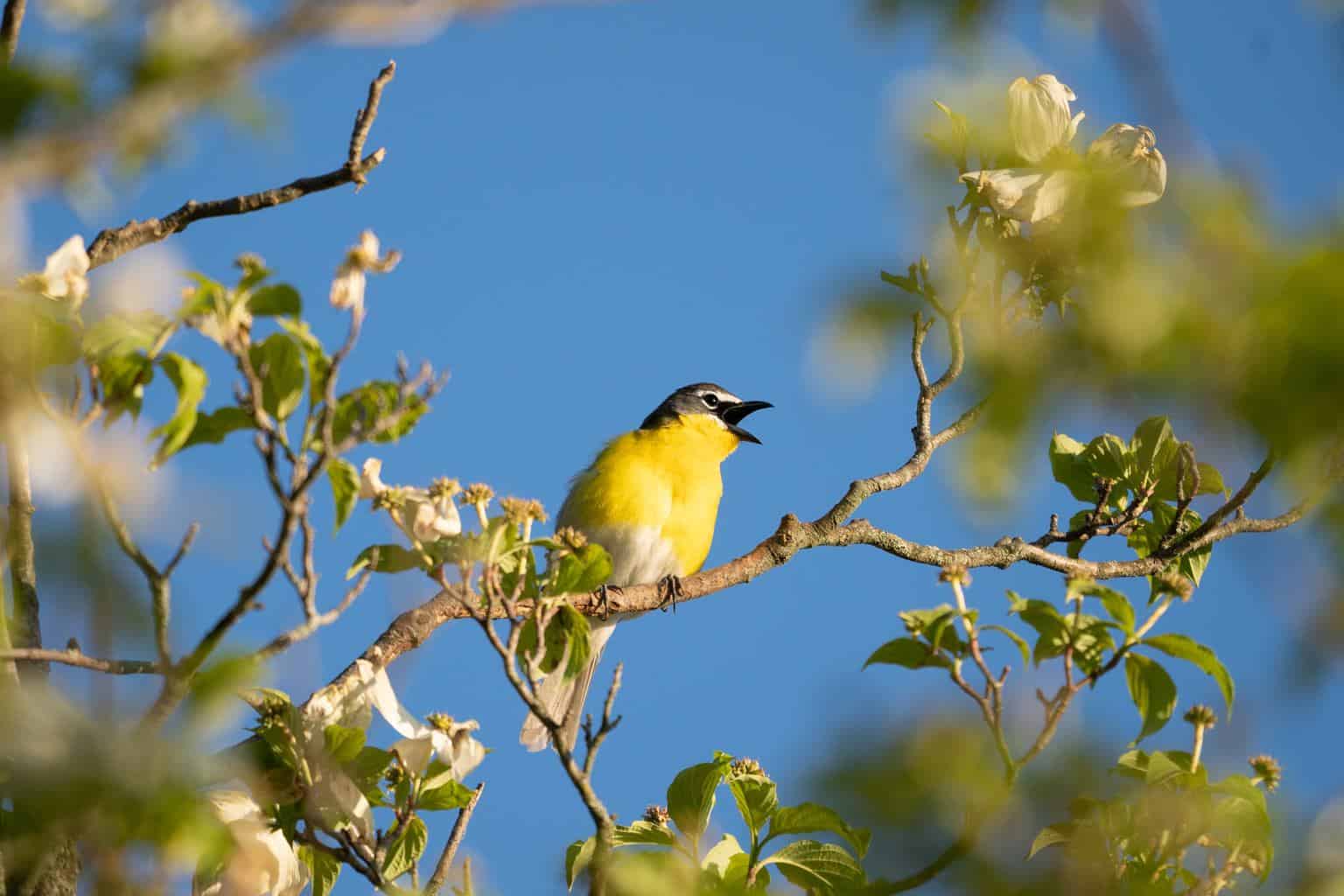
- Scientific Name: Icteria virens
- Length: 7 to 7.2 in.
- Weight: 0.9 to 1.1 oz.
- Wingspan: 9.8 to 10 in.
In Texas, Yellow-breasted chats visit between early April to early May. They’re recognized through their unmistakable streams of cackles, gargles, whistles, and chuckles all throughout spring.
Despite their brightly colored plumage, Yellow-breasted chats are more easily heard than seen. Outside spring, they’re seldom heard or seen, silently skulking in the shadows of dense thickets in search of food.
Yellow-breasted chats, as you may have guessed, have bright yellow breasts and olive green above. Their faces are boldly marked, making them appear like spectacles.
These gorgeous birds live in dense regrowing areas and thickets like clear cuts, bramble bushes, and shrubs along streams.
American Goldfinch

- Scientific Name: Spinus tristis
- Length: 4.3 to 5.5 in.
- Weight: 0.39 to 0.71 oz.
- Wingspan: 7.5 to 8.7 in.
It’s hard to miss the brilliant color of American goldfinches. These handsome little fellows are easy to find throughout much of Texas, abundant in areas with milkweed and thistle plants, as well as feeders.
Male American goldfinches are mostly yellow with black foreheads and black wings with white markings. Females are duller overall, with olive above and yellow beneath.
During winter, American goldfinches turn drab, buffy-brown.
Compared to most birds, American goldfinches are strict vegetarians. They often forage for seeds, buds, maple sap, and bark of young twigs, and would only inadvertently swallow the occasional insect.
Other Birds to Watch for in Texas
Northern Mockingbird
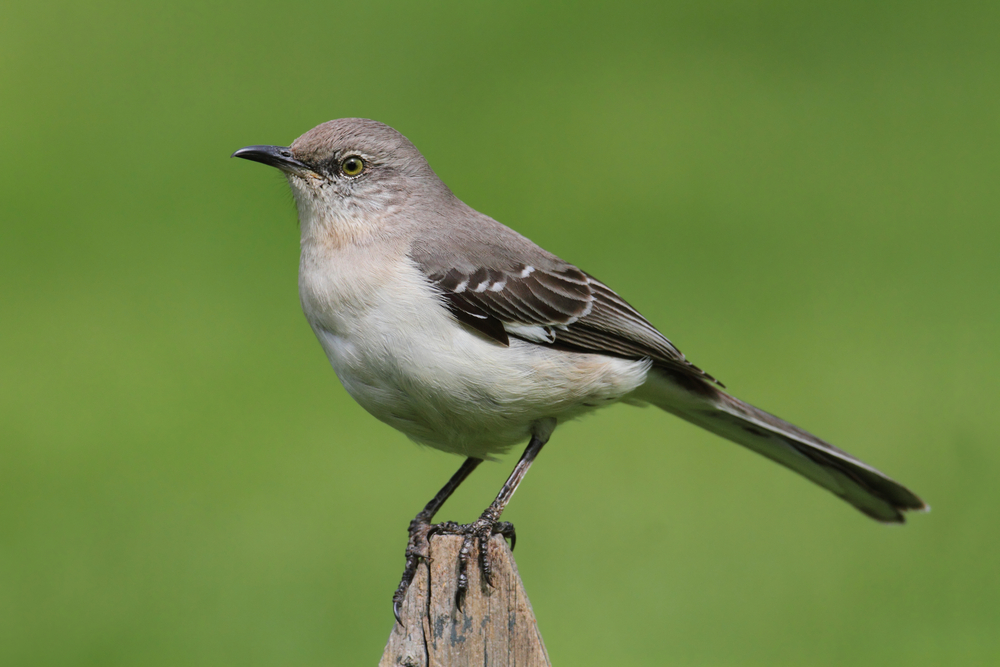
- Scientific Name: Mimus polyglottos
- Length: 8.3 to 10.2 in.
- Weight: 1.6 to 2 oz.
- Wingspan: 12.2 to 13.8 in.
Although Northern mockingbirds look fairly plain with their overall gray-brown plumage, their personalities are larger than life. It’s no wonder they’re hailed as the state bird of Texas!
Northern mockingbirds are widespread year-round throughout the United States, particularly in the southern and southeastern parts of the country.
Impressively, Northern mockingbirds can sing up to 200 songs, imitating the calls of birds around them and even sounds from amphibians and insects.
They’re also quite protective and loyal to their homes, swooping down and attacking anyone getting too close to their nests.
A birding trip in Texas wouldn’t be complete without taking a few snaps of Northern mockingbirds. You can find them at low elevations in forest edges, open land, suburbs, parks, and towns.
Crested Caracara

- Scientific Name: Caracara plancus
- Length: 19.2 to 22.8 in.
- Weight: 37 to 46 oz.
- Wingspan: 48 to 49.2 in.
Although they look like long-legged hawks or eagles, Crested caracaras are actually falcons. In Texas, they breed from January and September in open countries such as deserts, scrubs, pastures, and cultivated areas.
In a way, Crested caracaras behave similarly to vultures. In contrast to most raptors, they eat carrion alongside any animal they can possibly catch.
Crested caracaras are the only falcon species that collect materials to build a nest. Other falcons, in comparison, lay their eggs in scrapes on the ground and old nests built by another species.
Whooping Crane
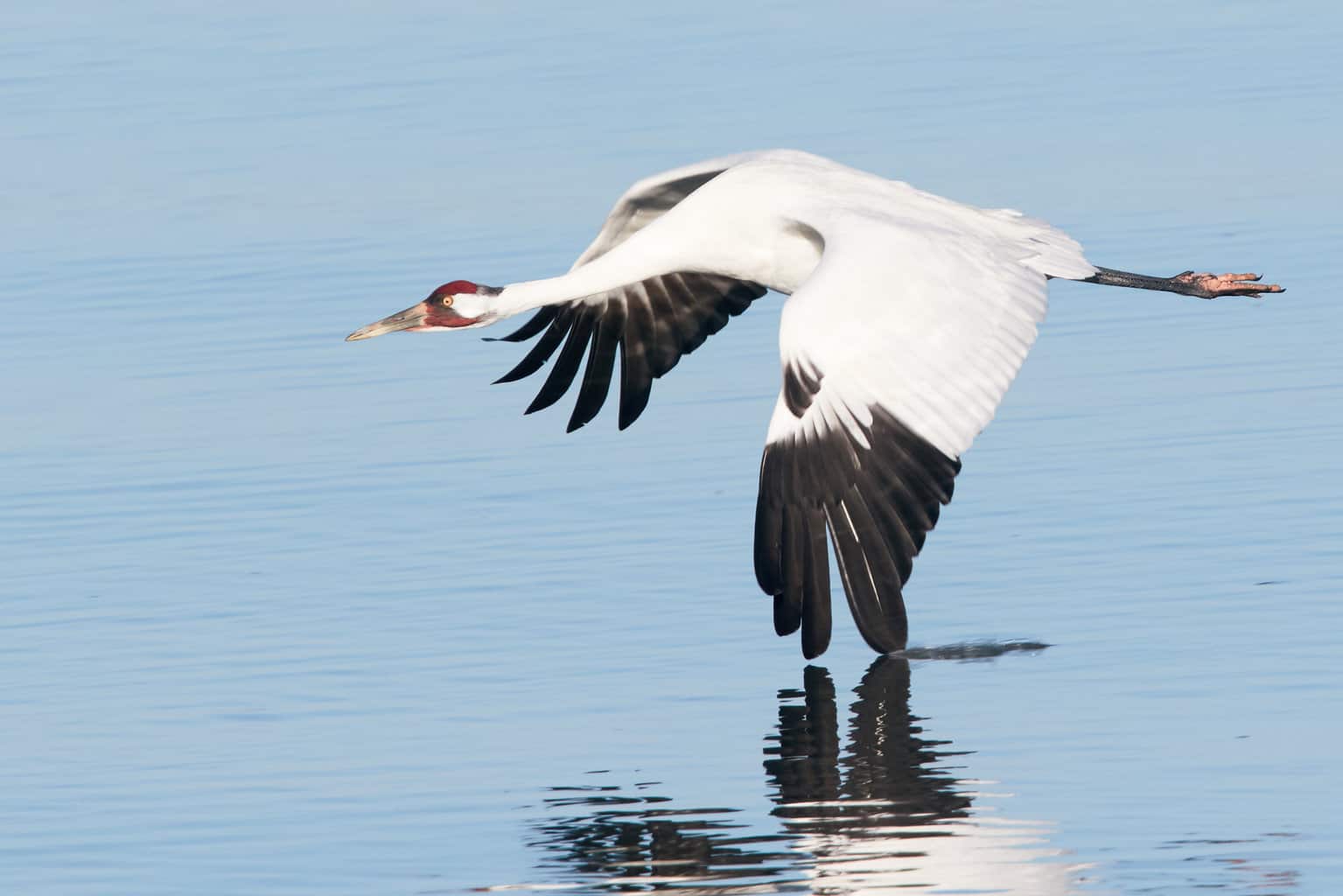
- Scientific Name: Grus americana
- Length: 59.1 in.
- Weight: 211.6 to 275.1 oz.
- Wingspan: 90.2 in.
Wary and naturally aggressive, Whooping cranes are the tallest birds in Texas and across North America, making them as stunning as they are intimidating. On average, these birds stand at a height of nearly five feet tall.
These beautiful, long-necked birds usually spend their winters on the Texas coast, particularly at the Aransas National Wildlife Refuge. Their fall migration begins in mid-September from the south to Texas.
Adult Whooping cranes are covered in snow-white plumage with accents of red on their heads. Juvelines are mottled brown above and whitish below.
You can find these graceful creatures in shallow, grassy wetlands with scattered evergreens. They’re among the rarest birds in the United States and are usually only found in Texas.
Great Horned Owl
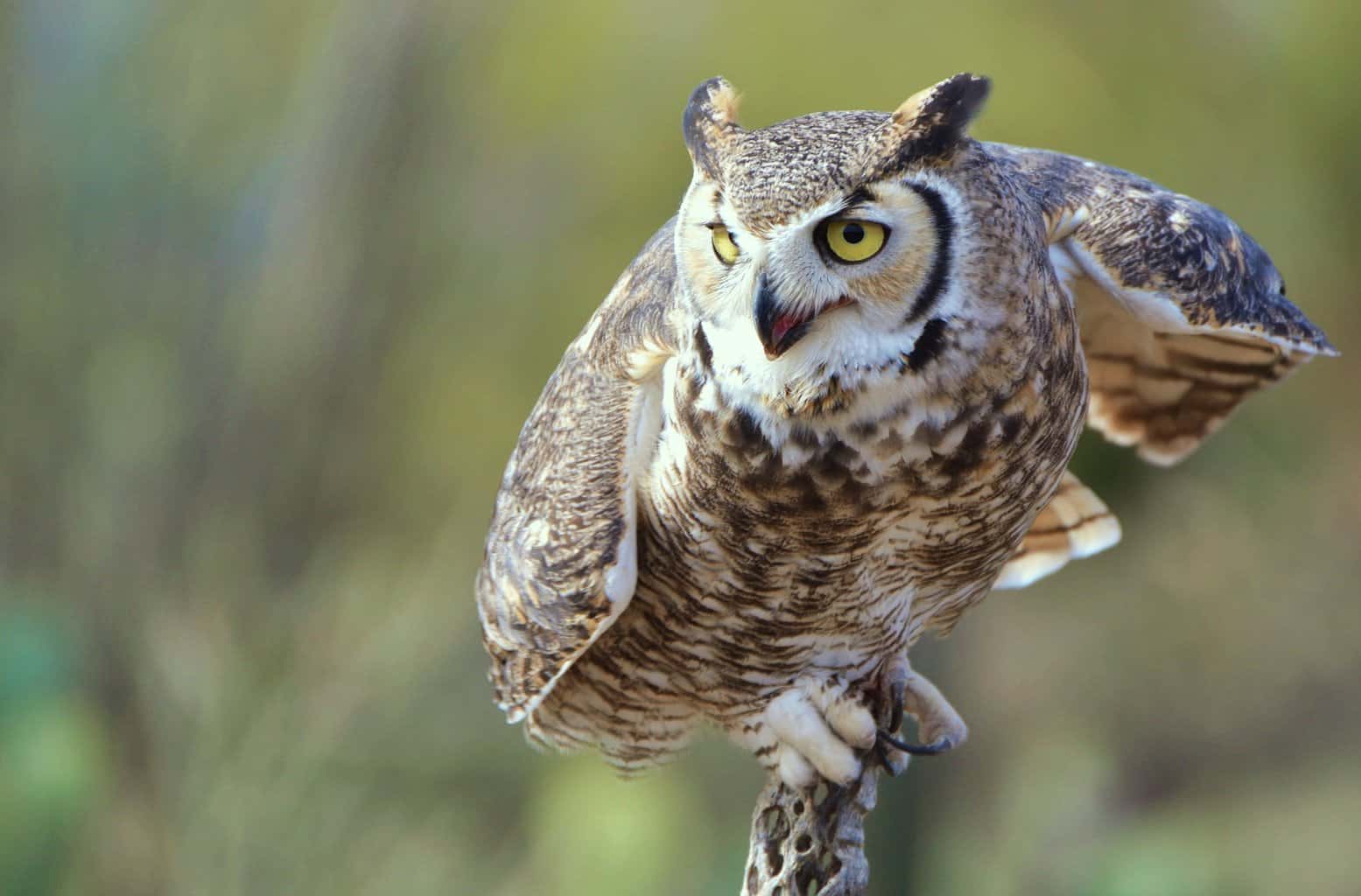
- Scientific name: Bubo virginianus
- Length: 24 in.
- Weight: 32.1 to 88.2 oz.
- Wingspan: 39.8 to 57.1 in.
Great horned owls are the largest and most common owl species in Texas, found year-round across the state. They can be spotted in multiple habitats, including deserts, forests, swamps, and even urban areas like city parks.
These owls are well-known for their deep hooting voice, intimidating yellow-eyed stare, and, most notably, their “horns,” which are really tufts of feathers sticking out on either side of their heads.
Conclusion
Although the Lone Star State is mostly famous for its BBQs, rodeos, and live music, you absolutely shouldn’t miss its gorgeous birdlife. From the secretive and elusive Streak-backed oriole to the powerful, no-nonsense Crested caracara, Texas truly has it all.
If you’re interested in more of the country’s birdlife, check out our list of the best species to look out for in New Hampshire!

